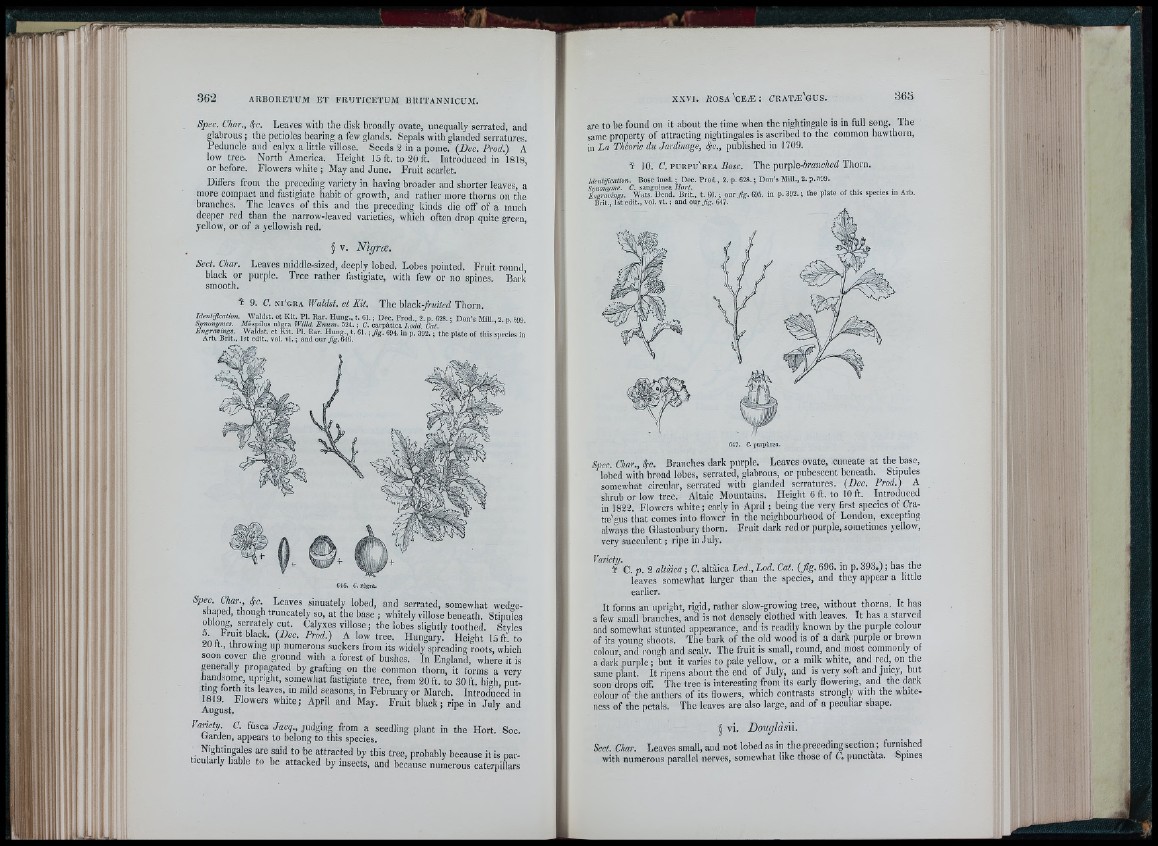
36-2
Spec. Char., f r . Leaves with the disk broadly ovate, unequally serrated, and
glabrous; the petioles bearing a few glands.’ Sepals with glanded serratures.
Peduncle and calyx a little villose. Seeds 2 in a pome. (Dec. Frod) A
low tree. North America. Height to f t , to 20 ft. Introduced in 1818,
o r before. Flowers white ; May and June. F ru it scarlet.
Differs from the preceding variety in having broader and shorter leaves, a
more compact and fastigiate habit of growth, and rather more thorns on the
branches. The leaves of this and th e preceding kinds die off of a much
deeper red than the narrow-leaved varieties, which often drop quite green,
yellow, or of a yellowish red.
§ V. Nigra;.
Sect. Char. Leaves middle-sized, deeply lobed. Lobes pointed. F ruit round,
black or purple. Tree rather fastigiate, with few or no spines. Bark
smooth.
The hlacXffruited Thorn.
; Don’s Mill., 2. p. 51)9.
9. C. N I 'G R A Waldst. et Kit.
Identification. Waldst. e t Kit. PI. Rar. Hung., t. 01. ; Dec. P rod., 2. p
Synonymes. A/espilus nigra Willd. E n um . 524. ; C. carpàtica hodd C
L vgravings Waldst. e t KiL PI. Rar. Hung. t. 61. ; fig . 694. in p. 392. ; th e plate of this species in
Arb. B n t., 1st edit., vol. VI. ; and our jîg.640. i c m u
646. C. n ig ra .
Spec. Char., f r . Leaves sinuately lobed, and serrated, somewhat wed»e-
shaped, though truncately so, at the base ; whitely villose beneath. Stipules
ftlo n g , serrately cut. Calyxes villose ; the lobes slightly toothed. Styles
■‘'’■“'‘•I ‘ree. Hungary. Height to f e t o
20 It., throwing up numerous suckers from its widely spreading roots, which
soon cover the ground with a forest of bushes. In England, where it is
p n e ra lly propagated by grafting on the common thorn, it forms a very
handftme, upright, somewhat fastigiate tree, from 20 ft. to 30 ft. high put-
'°reh Its leaves, in mild seasons, in February or March. Introduced in
A u g u st ' ’P® fo " “ 'y
Vanety C. fusca Jacq., judging from a seedling plant in the Hort. Soc.
Garden, appears to belong to this species.
Nightingales are said to be attracted by this tree, probably because it is particularly
liable to he attacked by insects, and because numerous caterpillars
ai-e to be found on it about the time when the niglitingale is in full song. The
same property of attracting nightingales is ascribed to the common hawthorn,
in La Théorie du Jardinage, ó'e., published in 1709.
î 10. C. puri'u' rea Rose. The purple-èra«cW Thorn.
I d e n tific a tio n . Bosc ined. ; Doc. P io d ., 2. p, 628. ; Don’s Mill., 2. p .599.
SvnoTii/me. C. sanguínea Hort. , , , , . . . . ,
E n g r a v in g s . Wats. Dend. Brit., t. 60. ; our f i g . 695. in p. 392. ; the plate of this species in Arb.
Brit., 1st edit., vol. vi. ; and o u t f i g . 647.
Spec. Char., f r . Branches dark purple. Leaves ovate, cuneate a t the base,
lobed with broad lobes, serrated, glabrous, or pubescent beneath. Stipules
somewhat circular, serrated with glanded serratures. (Dec. Frod.) A
shrub or low tree. Altaic Mountains. Height 6 ft. to 10 ft. Introduced
in 1822. Flowers wliite; early in April ; being tlie very first species of Cra-
tm'vus th a t comes into flower in the neighbourhood of London, excepting
always the Glastonbury thorn. F ruit dark red or purple, sometimes yellow,
very su ccu len t; ripe in Julj’.
I ^ ^ has the
leaves somewhat larger than the species, and they appear a little
earlier.
It forms an upright, rigid, rather slow-growing tree, without thorns. It has
a few small branches, and is not densely clothed with leaves. It has a starved
and somewhat stunted appearance, and is readily known by the purple colour
of its young shoots. Tlie bark of the old wood is of a dark purple or brown
colour, and rough and scalv. The fruit is small, round, and most commonly of
a dark pu rp le ; but it varies to pale yellow, or a milk white, and red, on the
same plant. I t ripens about the end of July, and is very soft and juicy, but
soon drops off. The tree is interesting from its early flowering, and the dark
colour of the anthers of its flowers, which contrasts strongly with the whiteness
of the petals. The leaves are also large, and of a peculiar shape.
§ vi. Dotigldsu.
Sect. Char. Leaves small, and not lobed as in the preceding section; furnished
with numerous parallel nerves, somewhat like those of C. punctata, bpines